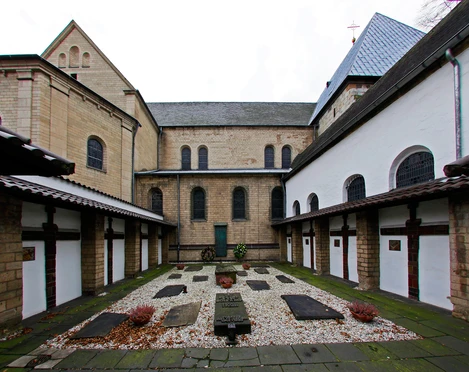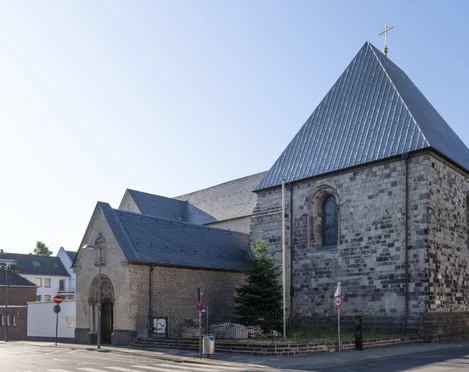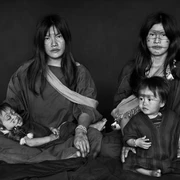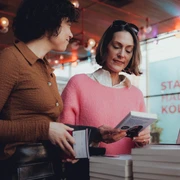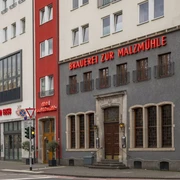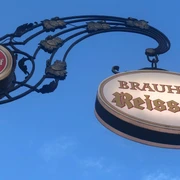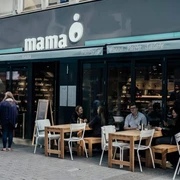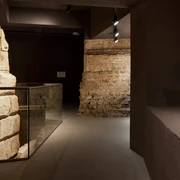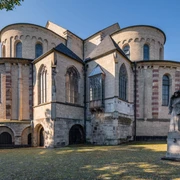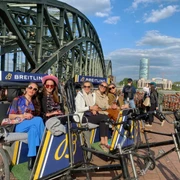- Photos & Map
How would you like to arrive?
- Call
- Details
- Useful Information
- Nearby
Music and singing can be experienced on many levels—surprisingly, even if you don't take them in with your ears. What sounds paradoxical becomes apparent at St. Georg, where the "Choir for the Eyes" regularly performs, transforming song into a physical aesthetic of movement through sign language—or more accurately, sign poetry. This is for the deaf, hard of hearing, and hearing individuals, within an inclusive community that has been active in Cologne for many years, shaping the parish life together.
Of course, the architectural history of St. Georg goes further back; it is one of the 12 Romanesque churches in Cologne, where you can walk reverently through the only remaining column basilica in the Rhineland.
If you're in Cologne on a Sunday, take the opportunity to visit—you might also enjoy the sign choir, bringing music to life on multiple levels.
However, the colorful leaded glass windows from 1928-1931, designed by Jan Thorn Prikker, can still be viewed as they were relocated during World War II or could be reconstructed. During your visit, make sure to stop by two notable features: the epitaph for the Dean Wilhelm Wysch from 1545 with its original color and the richly ornamented sacrament house from 1556.
After World War II, the church was rebuilt to its 1930 condition. The reconstruction took many long years, until 1964.
A better patron could hardly be imagined for this church with its inclusive concept...
Of course, the architectural history of St. Georg goes further back; it is one of the 12 Romanesque churches in Cologne, where you can walk reverently through the only remaining column basilica in the Rhineland.
Inclusive Events and Services
St. Georg is a place of diversity. Alongside many regular inclusive events and offerings, such as church tours, reflection days, and group meetings, there is a Holy Mass every Sunday with translation into sign language so that those with hearing impairments and those who can hear experience the service in all aspects equally. The use of technical hearing aids further ensures that inclusion and integration proceed smoothly.If you're in Cologne on a Sunday, take the opportunity to visit—you might also enjoy the sign choir, bringing music to life on multiple levels.
History of St. Georg
St. Georg, constructed in 1067 under Archbishop Anno II outside the Roman city and now just around the corner from the Chocolate Museum, stands on the remnants of Roman and Merovingian predecessor buildings. Like other Romanesque churches in Cologne, St. Georg has undergone several phases of transformation, renovations, new vault constructions, paintings, or wallings throughout its existence. In the Renaissance period around 1536, a porch was added, and during the Baroque period, a massive curved dome once crowned the wooden bell tower. Both were destroyed in World War II, and St. Georg, in general, was severely damaged.However, the colorful leaded glass windows from 1928-1931, designed by Jan Thorn Prikker, can still be viewed as they were relocated during World War II or could be reconstructed. During your visit, make sure to stop by two notable features: the epitaph for the Dean Wilhelm Wysch from 1545 with its original color and the richly ornamented sacrament house from 1556.
After World War II, the church was rebuilt to its 1930 condition. The reconstruction took many long years, until 1964.
St. Georg: On the Patron of the Church
Saint George symbolizes bravery, charity, courtesy, and chivalry, making him one of the most heroic models for Christianity and revered by the Crusaders. Legend has it that George freed Cappadocia from a dangerous dragon, preventing the sacrifice of the king's daughter, after which 20,000 people were baptized on the spot.A better patron could hardly be imagined for this church with its inclusive concept...
Useful Information
Eligibility
Bad Weather Offer
Suitable for any weather
for Groups
for Class
for families
for individual guests
Suitable for the Elderly
Openings
Payment methods
Entrance Free
Parking facilities
The walk from the stop "Poststraße" ( Tram: 3, 4, 16, 18) to the church St. Georg takes about 8 minutes.
Accessibility
Travel for Everyone
In Cologne, the name St. George does not stand alone for the almost 1000-year-old Romanesque church. Many people in Cologne associate St. George just as quickly with the chaplaincy for the hearing impaired and the integrative congregation of deaf, hard of hearing and hearing people, which has been based here for many years. When you hear the term "integration," you might think of two or even 10 individuals who feel welcomed by a large number of hearing people. But this is not so: At St. George, it's just different.
Here, people with and without hearing disabilities shape parish life together. Speaking lectors and lectors who recite the Word of God in sign language are equally active here. There is a sign choir that performs songs exclusively in sign language, and music opportunities for hearing people. Hearing impaired and hearing people meet for encounters on the high feast days, for the parish café or for the reunion after the vacation season. However, they also meet as separate groups. People with and without hearing disabilities prepare for marriage or baptism celebrations, find advice and accompaniment in life crises.
Of course, hearing and hearing-impaired children and young people also celebrate First Communion and Confirmation together. In St. George there is diversity, which gives everyone the opportunity to find their ecclesiastical home here. To make this possible, the church is equipped with technical hearing aids, and Holy Mass on Sunday mornings at 10:30 is translated into sign language.
There are deaf and hard-of-hearing clubs, a meeting of deaf unemployed people, and also everything else they expect from church. Everyone decides for themselves: Do I want to participate more in what is common, or do I attend the special offers for my group? People with hearing disabilities should be involved in the common events as much as possible; this is called: Inclusion; integration and inclusion are our goals. At St. George's, inclusion is something quite normal, just "all inclusive..."
Here, people with and without hearing disabilities shape parish life together. Speaking lectors and lectors who recite the Word of God in sign language are equally active here. There is a sign choir that performs songs exclusively in sign language, and music opportunities for hearing people. Hearing impaired and hearing people meet for encounters on the high feast days, for the parish café or for the reunion after the vacation season. However, they also meet as separate groups. People with and without hearing disabilities prepare for marriage or baptism celebrations, find advice and accompaniment in life crises.
Of course, hearing and hearing-impaired children and young people also celebrate First Communion and Confirmation together. In St. George there is diversity, which gives everyone the opportunity to find their ecclesiastical home here. To make this possible, the church is equipped with technical hearing aids, and Holy Mass on Sunday mornings at 10:30 is translated into sign language.
There are deaf and hard-of-hearing clubs, a meeting of deaf unemployed people, and also everything else they expect from church. Everyone decides for themselves: Do I want to participate more in what is common, or do I attend the special offers for my group? People with hearing disabilities should be involved in the common events as much as possible; this is called: Inclusion; integration and inclusion are our goals. At St. George's, inclusion is something quite normal, just "all inclusive..."
Nearby
